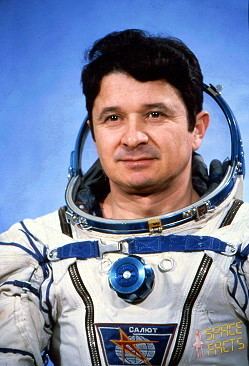Leonid Kizim
Russian - (RFSA)
Deceased
Date of Birth: Aug. 5, 1941
Date of Death: June 14, 2010
Leonid Denisovich Kizim (Кизим Леонид Денисович) (August 5, 1941 – June 14, 2010) was a Soviet cosmonaut. He was selected as a cosmonaut on October 23, 1965. Kizim flew as Commander on Soyuz T-3, Soyuz T-10 and Soyuz T-15, and also served as backup commander for Soyuz T-2. All together he spent 374 days 17 hours 56 minutes in space. On Soyuz T-15, he was part of the only crew to visit two space stations on one spaceflight (Mir and Salyut 7).
Soyuz-U | Soyuz T-3
Russian Federal Space Agency (ROSCOSMOS) | RussiaBaikonur Cosmodrome, Republic of Kazakhstan
Nov. 27, 1980, 2:18 p.m.
Status: Success
Mission:
Soyuz T-3 was the 13th mission to visit the Salyut 6 space station. It was the first Soyuz spacecraft since 1971 that carried three cosmonauts. The mission began on November 27, 1980, 14:18:28 UTC, launching Commander Leonid Kizim, Flight Engineer Oleg Makarov and Research Cosmonaut Gennady Strekalov into orbit. They docked with the station the next day. During their 11-day stay on the station, crew was busy with overhauling and maintenance work on the station, and also carried out usual experiments. The mission concluded with a safe landing back on Earth on December 10, 1980, 09:26:10 UTC.
Low Earth OrbitSoyuz-U | Soyuz T-10
Russian Federal Space Agency (ROSCOSMOS) | RussiaBaikonur Cosmodrome, Republic of Kazakhstan
Feb. 8, 1984, 12:07 p.m.
Status: Success
Mission:
Soyuz T-10 was the third long-duration expedition to the Salyut 7 space station. The mission began on 8 February 1984, 12:07:26 UTC, launching Commander Leonid Kizim, Flight Engineer Vladimir Solovyov and Research Cosmonaut Oleg Atkov into orbit. They docked with the station the next day. During their 237-day stay on the station, crew performed various scientific and medical experiments, performed six EVAs for station maintenance, and were visited by Soyuz T-11 and Soyuz T-12 missions. Soyuz T-10, per usual, swapped vehicles with the Soyuz T-11 crew, which allowed for a longer stay on the station. The mission concluded with a safe landing back on Earth on October 2, 1984, 10:57:00 UTC.
Low Earth OrbitSoyuz-U | Soyuz T-11
Russian Federal Space Agency (ROSCOSMOS) | RussiaBaikonur Cosmodrome, Republic of Kazakhstan
April 3, 1984, 1:08 p.m.
Status: Success
Mission:
Soyuz T-11 was the sixth mission to visit the Salyut 7 space station and the first to visit the long-duration Soyuz T-10 resident crew of the station. The mission began on April 3, 1984, 13:08:00 UTC, launching Commander Yury Malyshev, Flight Engineer Gennady Strekalov and Research Cosmonaut Rakesh Sharma, the first Indian cosmonaut, into orbit. They docked with the station the next day. During their 7-day stay on the station, crew performed various scientific experiments. Soyuz T-11, per usual, swapped their vehicles with the resident Soyuz T-10 crew, which allowed for a longer stay on the station. The crew returned in Soyuz T-11 spacecraft, landing safely back on Earth on October 2, 1984, 10:57:00 UTC.
Low Earth OrbitSoyuz-U2 | Soyuz T-15
Soviet Space Program | RussiaBaikonur Cosmodrome, Republic of Kazakhstan
March 13, 1986, 12:33 p.m.
Status: Success
Mission:
Soyuz T-15 was the last mission to visit the Salyut 7 space station and the first to visit the Mir space station. The mission began on March 13, 1986, 12:33:09 UTC, launching Commander Leonid Kizim and Flight Engineer Volodimir Solovyov into orbit. They docked with Mir two days later. During their stay there, crew tested station's systems and were visited by two Progress cargo spacecrafts. On May 5, 1986, 12:12:09 UTC crew undocked from Mir and docked with Salyut the next day. There they collected experiments results, instruments and performed two EVAs. On June 25 crew undocked from Salyut 7 and returned to Mir the next day. The mission concluded with a safe landing back on Earth on July 16, 1986, 12:34:05 UTC.
Low Earth OrbitThe Roscosmos State Corporation for Space Activities, commonly known as Roscosmos, is the governmental body responsible for the space science program of the Russian Federation and general aerospace research. Soyuz has many launch locations the Russian sites are Baikonur, Plesetsk and Vostochny however Ariane also purchases the vehicle and launches it from French Guiana.
Long March 12A
Demo Flight
Long March 12A Pad - Jiuquan Satellite Launch Center, People's Republic of ChinaFirst test launch of CASC/SAST’s Long March 12A rocket, with a dummy payload. The rocket’s 1st stage attempted to land on a landing pad about 300 km …
HANBIT-Nano
Spaceward
HANBIT Pad - Alcântara Space Center, Federative Republic of BrazilMaiden orbital launch attempt for the South Korean stratup Innospace and its HANBIT-Nano small launch vehicle. Onboard this flight are five small sat…
H3-22
Michibiki 5 (QZS-5)
Yoshinobu Launch Complex LP-2 - Tanegashima Space Center, JapanQZSS (Quasi Zenith Satellite System) is a Japanese satellite navigation system operating from inclined, elliptical geosynchronous orbits to achieve o…
Electron
The Wisdom God Guides (iQPS Launch 6)
Rocket Lab Launch Complex 1B - Rocket Lab Launch Complex 1, Mahia Peninsula, New ZealandSynthetic aperture radar Earth observation satellite for Japanese Earth imaging company iQPS.
New Shepard
NS-37
West Texas Suborbital Launch Site/ Corn Ranch - Corn Ranch, Van Horn, TX, USANS-37 is the 16th crewed flight for the New Shepard program and the 37th in the New Shepard program's history.




